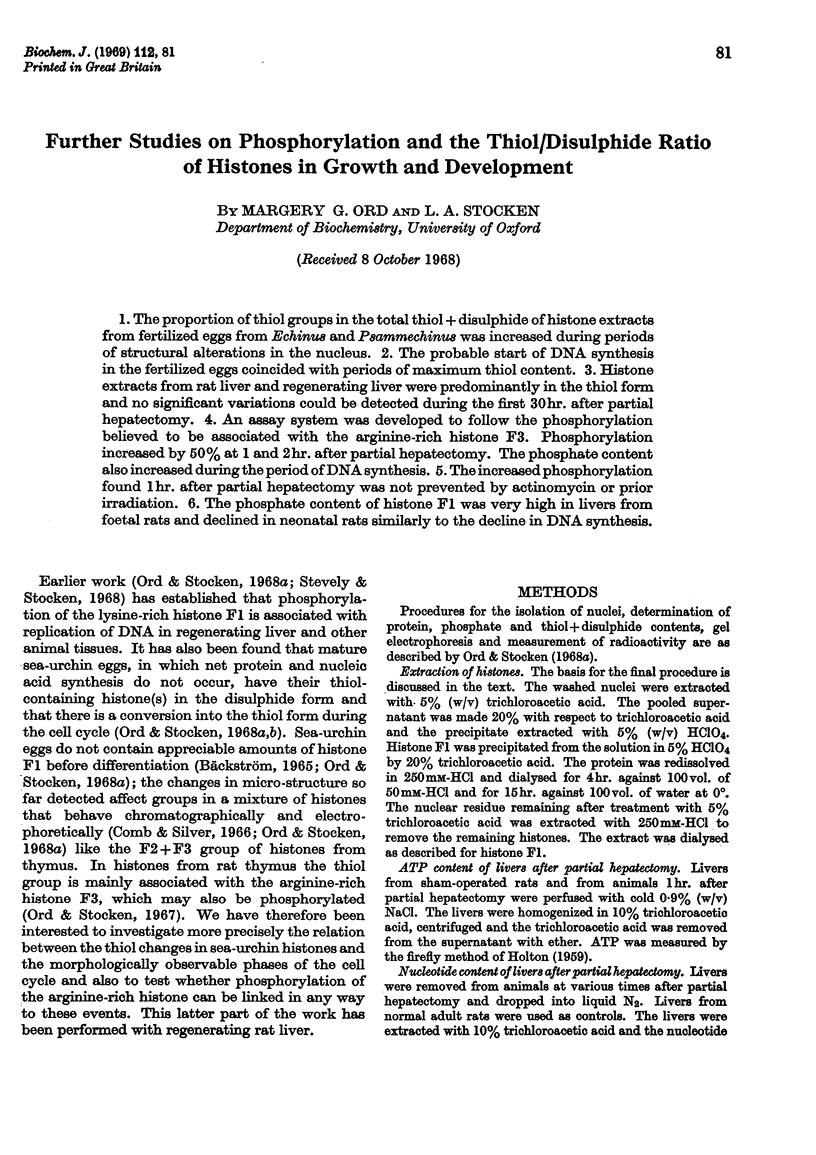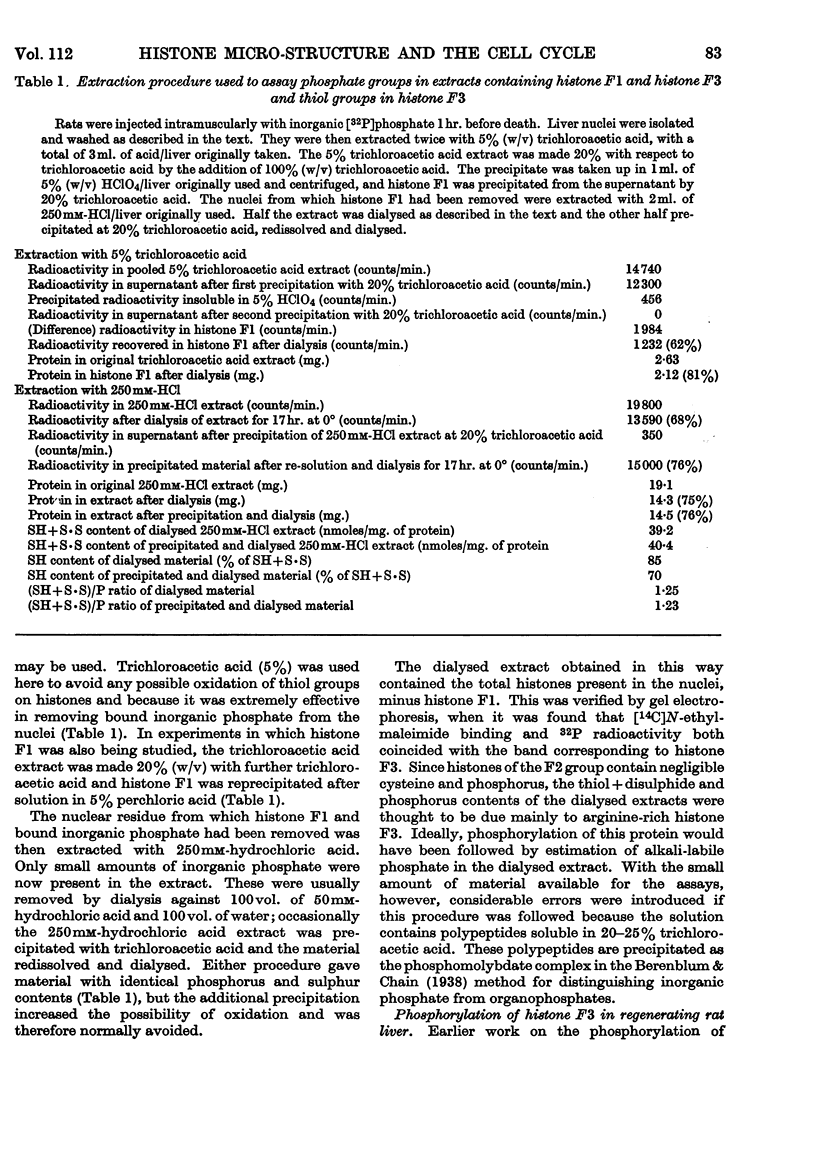Abstract
1. The proportion of thiol groups in the total thiol+disulphide of histone extracts from fertilized eggs from Echinus and Psammechinus was increased during periods of structural alterations in the nucleus. 2. The probable start of DNA synthesis in the fertilized eggs coincided with periods of maximum thiol content. 3. Histone extracts from rat liver and regenerating liver were predominantly in the thiol form and no significant variations could be detected during the first 30hr. after partial hepatectomy. 4. An assay system was developed to follow the phosphorylation believed to be associated with the arginine-rich histone F3. Phosphorylation increased by 50% at 1 and 2hr. after partial hepatectomy. The phosphate content also increased during the period of DNA synthesis. 5. The increased phosphorylation found 1hr. after partial hepatectomy was not prevented by actinomycin or prior irradiation. 6. The phosphate content of histone F1 was very high in livers from foetal rats and declined in neonatal rats similarly to the decline in DNA synthesis.
Full text
PDF








Selected References
These references are in PubMed. This may not be the complete list of references from this article.
- ALLFREY V. G., FAULKNER R., MIRSKY A. E. ACETYLATION AND METHYLATION OF HISTONES AND THEIR POSSIBLE ROLE IN THE REGULATION OF RNA SYNTHESIS. Proc Natl Acad Sci U S A. 1964 May;51:786–794. doi: 10.1073/pnas.51.5.786. [DOI] [PMC free article] [PubMed] [Google Scholar]
- Ando T., Suzuki K. The amino acid sequence of the third component of clupeine. Biochim Biophys Acta. 1967 Jun 27;140(2):375–377. doi: 10.1016/0005-2795(67)90481-3. [DOI] [PubMed] [Google Scholar]
- Berenblum I., Chain E. An improved method for the colorimetric determination of phosphate. Biochem J. 1938 Feb;32(2):295–298. doi: 10.1042/bj0320295. [DOI] [PMC free article] [PubMed] [Google Scholar]
- Cohen P., Kidson C. Conformational analysis of DNA-poly-L-lysine complexes by optical rotatory dispersion. J Mol Biol. 1968 Jul 14;35(1):241–245. doi: 10.1016/s0022-2836(68)80052-x. [DOI] [PubMed] [Google Scholar]
- Comb D. C., Silver D. J. Synthesis of basic proteins and cellular RNA species during sea urchin development. Natl Cancer Inst Monogr. 1966 Dec;23:325–336. [PubMed] [Google Scholar]
- FERRARI V., HARKNESS R. D. Free amino-acids in liver and blood after partial hepatectomy in normal and adrenalectomized rats. J Physiol. 1954 Jun 28;124(3):443–463. doi: 10.1113/jphysiol.1954.sp005120. [DOI] [PMC free article] [PubMed] [Google Scholar]
- Frenster J. H. Nuclear polyanions as de-repressors of synthesis of ribonucleic acid. Nature. 1965 May 15;206(985):680–683. doi: 10.1038/206680a0. [DOI] [PubMed] [Google Scholar]
- HOLTON P. The liberation of adenosine triphosphate on antidromic stimulation of sensory nerves. J Physiol. 1959 Mar 12;145(3):494–504. doi: 10.1113/jphysiol.1959.sp006157. [DOI] [PMC free article] [PubMed] [Google Scholar]
- HURLBERT R. B., SCHMITZ H., BRUMM A. F., POTTER V. R. Nucleotide metabolism. II. Chromatographic separation of acid-soluble nucleotides. J Biol Chem. 1954 Jul;209(1):23–39. [PubMed] [Google Scholar]
- Ingles C. J., Dixon G. H. Phosphorylation of protamine during spermatogenesis in trout testis. Proc Natl Acad Sci U S A. 1967 Sep;58(3):1011–1018. doi: 10.1073/pnas.58.3.1011. [DOI] [PMC free article] [PubMed] [Google Scholar]
- JOHNS E. W., BUTLER J. A. SPECIFICITY OF THE INTERACTIONS BETWEEN HISTONES AND DEOXYRIBONUCLEIC ACID. Nature. 1964 Nov 28;204:853–855. doi: 10.1038/204853a0. [DOI] [PubMed] [Google Scholar]
- Johns E. W. Studies on histones. 7. Preparative methods for histone fractions from calf thymus. Biochem J. 1964 Jul;92(1):55–59. doi: 10.1042/bj0920055. [DOI] [PMC free article] [PubMed] [Google Scholar]
- Kubinski H., Opara-Kubinska Z., Szybalski W. Patterns of interaction between polyribonucleotides and individual DNA strands derived from several vertebrates, bacteria and bacteriophages. J Mol Biol. 1966 Sep;20(2):313–329. doi: 10.1016/0022-2836(66)90067-2. [DOI] [PubMed] [Google Scholar]
- Ord M. G., Stocken L. A. Metabolic properties of histones from rat liver and thymus gland. Biochem J. 1966 Mar;98(3):888–897. doi: 10.1042/bj0980888. [DOI] [PMC free article] [PubMed] [Google Scholar]
- Ord M. G., Stocken L. A. Phosphate and thiol groups in histone f3 from rat liver and thymus nuclei. Biochem J. 1967 Feb;102(2):631–636. doi: 10.1042/bj1020631. [DOI] [PMC free article] [PubMed] [Google Scholar]
- Ord M. G., Stocken L. A. Variations in the microstructure of histones during early cleavage stages in Echinus. Biochem J. 1968 Sep;109(3):24P–24P. doi: 10.1042/bj1090024pa. [DOI] [PMC free article] [PubMed] [Google Scholar]
- Ord M. G., Stocken L. A. Variations in the phosphate content and thiołdisulphide ratio of histones during the cell cycle. Studies with regenerating rat liver and sea urchins. Biochem J. 1968 Apr;107(3):403–410. doi: 10.1042/bj1070403. [DOI] [PMC free article] [PubMed] [Google Scholar]
- POTTER R. L., SCHLESINGER S., BUETTNER-JANUSCH V., THOMPSON L. The isolation of pyrimidine deoxyribonucleotides from the acid-soluble extract of thymus. J Biol Chem. 1957 May;226(1):381–394. [PubMed] [Google Scholar]
- Pogo B. G., Pogo A. O., Allfrey V. G., Mirsky A. E. Changing patterns of histone acetylation and RNA synthesis in regeneration of the liver. Proc Natl Acad Sci U S A. 1968 Apr;59(4):1337–1344. doi: 10.1073/pnas.59.4.1337. [DOI] [PMC free article] [PubMed] [Google Scholar]
- REVEL M., HIATT H. H. THE STABILITY OF LIVER MESSENGER RNA. Proc Natl Acad Sci U S A. 1964 May;51:810–818. doi: 10.1073/pnas.51.5.810. [DOI] [PMC free article] [PubMed] [Google Scholar]
- SHERMAN F. G., FORSSBERG A. Incorporation of P32 into trichloroacetic acid fractions of liver from irradiated and nonirradiated mice. Arch Biochem Biophys. 1954 Feb;48(2):293–299. doi: 10.1016/0003-9861(54)90343-4. [DOI] [PubMed] [Google Scholar]
- Sekeris C. E., Beato M., Homoki J., Congote L. F. Effect of cortisol on the thiol content of nuclear proteins of isolated rat liver nuclei. Hoppe Seylers Z Physiol Chem. 1968 Jun;349(6):857–858. [PubMed] [Google Scholar]
- Stevely W. S., Stocken L. A. Variations in the phosphate content of histone F1 in normal and irradiated tissues. Biochem J. 1968 Nov;110(2):187–191. doi: 10.1042/bj1100187. [DOI] [PMC free article] [PubMed] [Google Scholar]
- Vidali G., Neelin J. M. A comprehensive fractionation procedure for avian erythrocyte histones. Eur J Biochem. 1968 Aug;5(3):330–338. doi: 10.1111/j.1432-1033.1968.tb00374.x. [DOI] [PubMed] [Google Scholar]
- Zimmerman A. M., Silberman L. Studies on incorporation of 3H-thymidine in Arbacia eggs under hydrostatic pressure. Exp Cell Res. 1967 Jun;46(3):469–476. doi: 10.1016/0014-4827(67)90373-4. [DOI] [PubMed] [Google Scholar]


